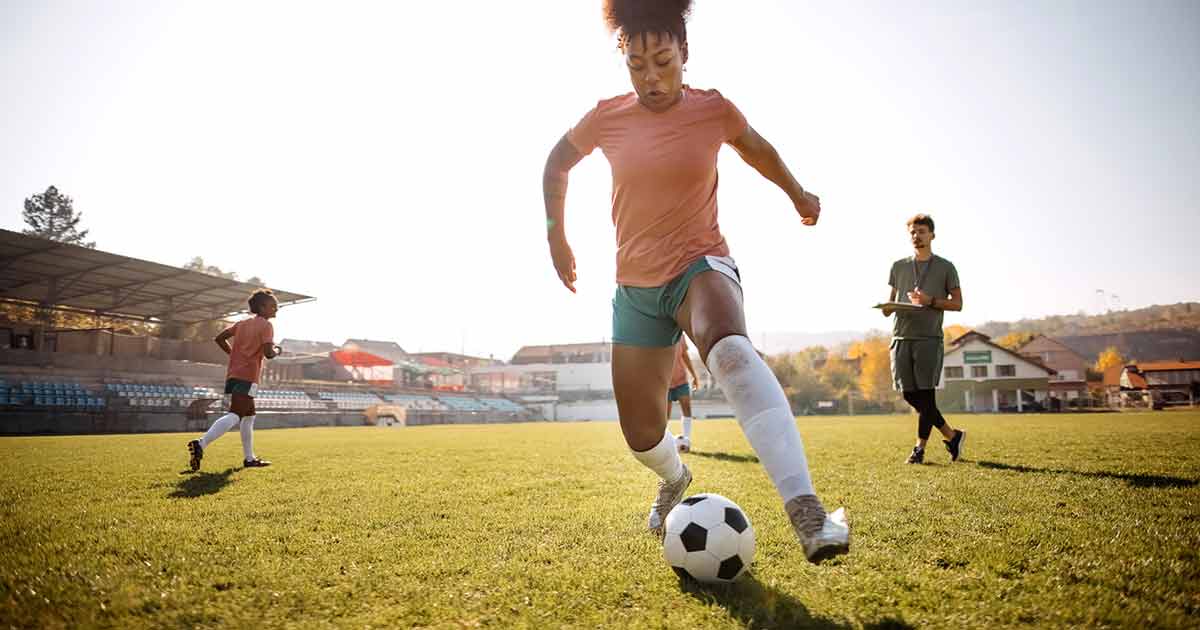
Advice to improve your movement, fitness, and overall health from the #1 in orthopedics in the U.S.
Why Soccer Players Are at Higher Risk of ACL Injury
Patterns of movement typical of soccer can cause stress on the knee, causing injury to the ACL.
Advice to improve your movement, fitness, and overall health from the #1 in orthopedics in the U.S.
Anterior cruciate ligament (ACL) tears are one of the most common injuries seen among soccer players, particularly females. According to HSS orthopedic surgeon Riley Williams III, MD, this injury is most closely associated with soccer for three main reasons:

- Typical movements in soccer can cause stress on an ACL. High-velocity changes in direction, pivots and rotation of lower extremities can affect the function and stability of an ACL. For example, when a player passes the ball from one side of the field to the other using a right-to-left motion, they rotate with the left foot fixed to the ground around the left knee but are kicking the ball across their body. That rotation happens at a velocity and force that is well beyond that of normal activity, which can lead to an ACL injury, says Dr. Williams.
- Contact and non-contact with another player. ACL injuries can occur when contact is made with another player, such as a tackle from the side causing a valgus, or outward, force to the knee or “knock knee,” says Dr. Williams. Similarly, non-contact soccer injuries to the ACL are commonly caused by the repetitive and quick movements mentioned above or landing awkwardly.
- Anatomy of a player. The anatomy of an athlete, especially female soccer players, can contribute to the potential risk of an ACL injury:
- Female soccer athletes differ from male athletes because of the alignment of their hips and knees. This difference is associated with knee valgus alignment, which increases the likelihood of ACL injury— especially when movements are completed in high velocity, as they are in soccer, says Dr. Williams.
- The femoral notch, where the ACL lives, tends be narrower in females than in males. If the knee or femur twists around the tibia, the ACL is impinged upon by bone, causing injury.
- Studies also have indicated that hormonal changes in women can impact the likelihood of sustaining an ACL injury.
Preventing ACL Injury in Soccer Players
“To really maximize athletic ability and prevent soccer-related injuries like ACL tears, it is important for players to have a full understanding of the nature of the game and how it requires high-velocity and rotational body movements,” says Dr. Williams. One way to avoid initial or reoccurring ACL injury is for players to maintain fitness and training schedules throughout the season. Focusing on strength and conditioning of a player’s core, hip and thigh muscles in relation to common soccer movements will help players avoid initial injury as well as re-injury to an ACL, he adds.
“Likewise, to improve upon the care provided to patients with ACL injuries, sports medicine surgeons at HSS participate in an ACL registry that enables them to conduct prospective analysis of post ACL injury outcomes as well as utilize the expertise of a large sports service that works collaboratively to conduct a high volume of ACL surgeries and is instrumental in effectively determining a safe return to play for athletes,” says Dr. Williams. “Together, advanced treatments coupled with continued physical fitness will help players gain the necessary strength and ability to prevent injury and appropriately recover if injury has occurred.”
Published 10/3/2022


